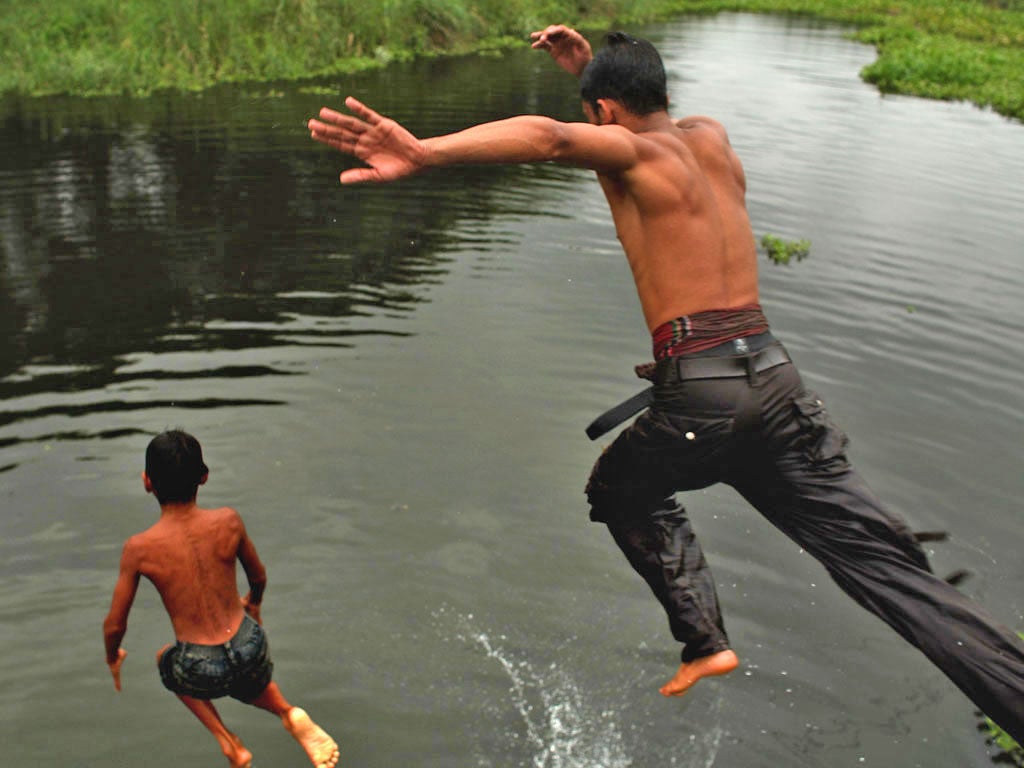Bangladesh: Where swimming lessons are a matter of life and death
A Bangladeshi child drowns every half hour. So why are so few taught to swim? David Bergman in Dhaka looks at a project trying to change that

It is a silent epidemic, causing the deaths of more children in Bangladesh than all the familiar child killers of tuberculosis, malaria, tetanus, whooping cough and polio put together.
Every year around 18,000 Bangladeshi children under the age of 17 die from drowning in ponds, rivers and other bodies of water that make up this low-lying country. This translates to a child dying every half an hour – 46 every day – thought to be one of the highest rates of child drowning anywhere in the world.
The story of 11-year-old Enamul, from a small village in the district of Narsingdi in central Bangladesh, is all too familiar. "He went to play with his friends," his mother Hosna said. "They made a raft out of banana tree leaves and took it out on the pond behind our houses." The young boy then reached in the water to pick up the raft but fell in. He could not swim, and drowned.
"All the pain I felt when I was in labour with him is nothing to the pain I feel now. When I think of him, my heart breaks," Hosna says.
Tragedy also befell Sajeda. She left her two sons, three-year-old Hassan and Hossain, 10, to play around the house while she went to work. But again, the local pond proved a tempting draw for the youngsters, who could not swim. When Sajeda returned from work, she couldn't find her sons. After a search was mounted, the two boys were discovered face down in the pond.
But there is hope that many of these deaths could be avoided. Five years ago, the Centre for Injury Prevention and Research, based in the capital Dhaka, started a programme called SwimSafe, which last year gave swimming instruction to 80,000 children aged between four and 10 throughout the country.
Since the project began, 210,000 children have learnt to swim with the project's success now being replicated in Thailand and Vietnam.
"There are lots of rivers, lakes, ponds [and other] water bodies all over Bangladesh. In every village there is a pond or ditch and this is the place where children, who are often not under supervision, go and play", said, Dr Jehangir Hossain, the programme co-ordinator.
"If children learn to swim in Bangladesh at all it is usually after they are 10 years old. It is the young children who are the main victims."
The children are not just taught how to swim but how to rescue somebody who is drowning and to identify life-threatening water hazards. To graduate from the course, a child must prove they can tread water for 90 seconds and swim unassisted in open water for at least 25 metres.
In rural areas, where most of the classes take place, the swimming instruction takes place in local ponds which are cordoned off using bamboo. The centre has recruited 580 community swimming instructors who live in the local areas where the training takes place.
"When we started most of the instructors were men, but we found that women were much more reliable, and were available to do the lessons. So now most of the instructors are women," said Dr Hossain.
This is also very important to encourage families to send their daughters to the lessons. Young girls are all too often the victims, taken out of school or forced into marriages very young, thus never learning to swim and unable to pass these life-saving skills on to their children.
But it is not just rural children who are at risk of drowning in Bangladesh. It is common for families who live in the big cities of Dhaka or Chittagong to head to the beaches in Cox's Bazar or on St Martin's Island for a holiday, or to go back to their village home where they again face the dangers of playing in ponds. So the programme is beginning to focus on these children as well. Last year, 3,000 children in urban areas received swimming lessons. Since there are very few public swimming pools in urban Bangladesh, the SwimSafe programme uses specially constructed portable pools.
It seems that the programme is having an impact. The number of child deaths from drowning has fallen by 50 per cent in areas where swimming lessons have taken place, says Dr Hossain, based on the centre's own research and surveillance over the last five years. A particular challenge is to reduce the high number of drownings among children under the age of four. The Centre for Injury Prevention and Research is trialling village crèches for four or five hours a day to see if improved supervision will reduce the high number of deaths. "We have just finished the research which was successful and we hope to be able to get funding to organise crèches around the country," said Dr Hossain.
The SwimSafe programme currently receives most of its funding from Unicef but also receives support from the Alliance for Safe Children, Royal Life Saving Society Australia and the Bangladesh Swimming Federation.
One of those who received swimming instruction a few months ago was Hosna's surviving son. After losing one son, she was determined to make sure her other son did not suffer the same fate. And as he received his first lesson, Hosna watched on beaming.
Join our commenting forum
Join thought-provoking conversations, follow other Independent readers and see their replies
Comments